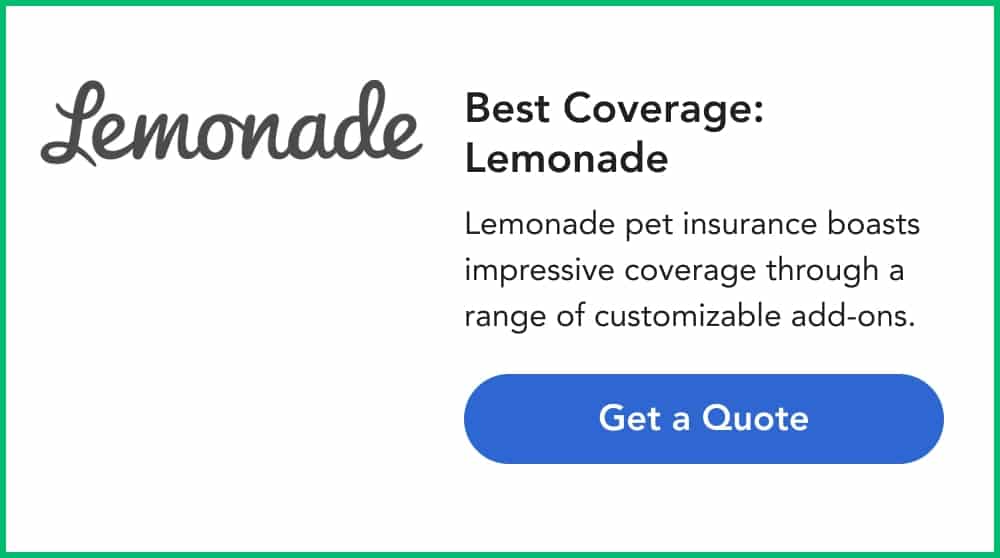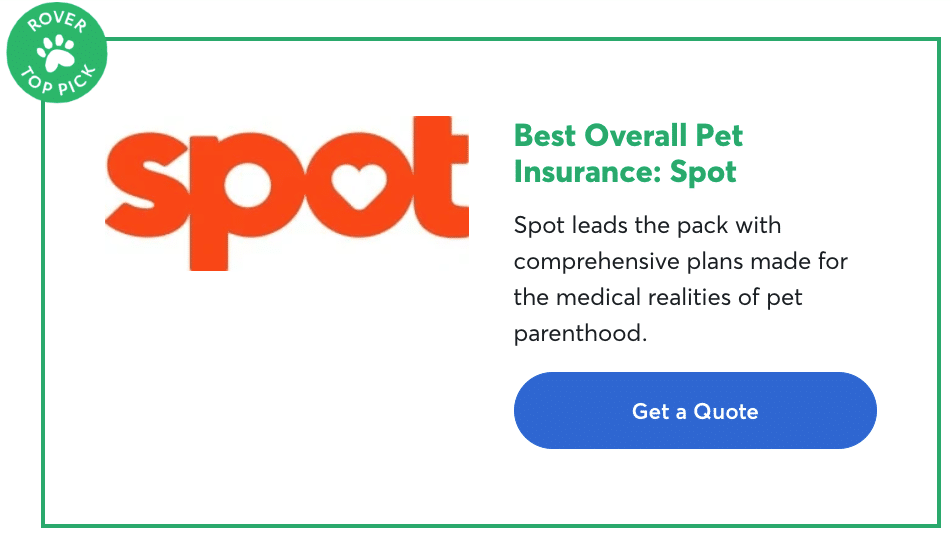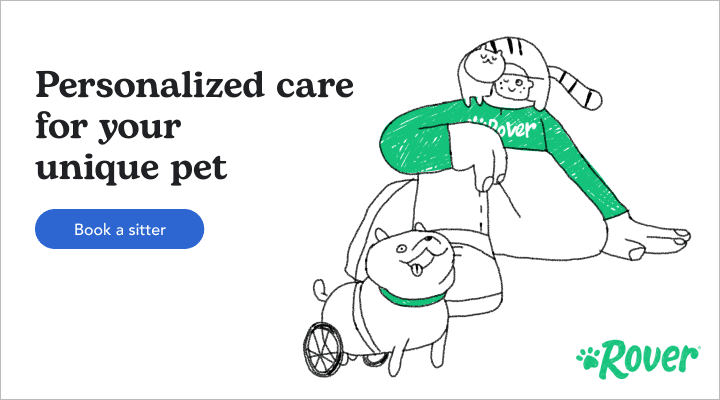- This post contains affiliate links. Read more here.
- Not a substitute for professional veterinary help.
Considering pet insurance but not sure how to pick a provider or a plan? You’re not alone. There are more pet insurance companies than ever to choose from and a huge range of policies on the market. Plus everyone’s financial situations and pets are different, which means that the best pet insurance plan for each person is also different.
That’s why we’ve put together this step-by-step guide to take you through the process of choosing pet insurance, with some tips to help you find the policy that works best for you and your furry friend.
- Know why you want pet insurance
- Consider your pet’s age and pre-existing conditions
- Learn about your pet’s breed and health risks
- Decide what kind of extras and add-ons you need
- Compare quotes and customize your plan
1. Know Why You Want Pet Insurance
Ultimately, everyone’s reasons for getting pet insurance are different—and what they are can significantly change what kind of policy you’re looking for. That’s why step one is identifying your goals. Here are some examples.
| Your reason: | You might want: |
| You want to make sure you can always say yes to life-saving treatment |
|
| You always want to be able to prioritize your pet’s care over your wallet |
|
| You want to avoid big financial shocks from your pet’s healthcare |
|
| You just want some help with vet bills |
|
You want to make sure that you can always say yes to life-saving treatment
For some pet parents, getting pet insurance is about avoiding a catastrophic situation where they might have to choose between their financial security and life-saving treatment for their pet. Treatment for some illnesses—notably cancer—can cost upwards of $8,000.
If always being able to say yes to critical treatment is your main objective, know your cut-off point. How much money would be too much for you to pay out of pocket? That might be your threshold when it comes time to choose a deductible and an annual limit. How much can you afford per month to ensure that happens? That’s your budget for premiums.
It’s also possible that with life-saving care as your goal, you might not need a fancy plan with all the bells and whistles, like coverage for alternative therapies and 24/7 vet lines. You could prioritize solid coverage with good premiums and skip the add-ons.
Both Pets Best and Prudent Pet offer popular straightforward plans without too many price-hiking add-ons.
You always want to be able to prioritize your pet’s care over your wallet
Some pet parents want to feel financially free to pursue all kinds of pet healthcare, not just the life-saving stuff. A comprehensive pet insurance plan, like Spot’s, can offer coverage for a wide range of treatments, from big quality-of-life surgeries to hydrotherapy and vet-recommended behavioral treatments.
This does come at a price, though, which is typically higher monthly premiums. Consider what kind of treatments are most important to you and how much you’d be willing to pay for the option to have coverage for them. It’s easy to get swayed by all the add-ons and perks, so know your priorities and have a firm budget in mind as you shop.
You want to avoid big financial shocks as a result of your pet’s healthcare
Ultimately, pet insurance is a decision about how you like to run your money. Maybe you know you could cover most emergencies in a pinch, but you hate the idea of a sudden drain on your savings and the unpredictability of emergency vet bills. You’d rather pay a guaranteed smaller amount every month than face the unexpected.
If that’s you, your priority might be regularity—a reasonably comprehensive plan, a small deductible, and maybe a wellness add-on to regulate even routine expenses.
Spot is a popular choice for good coverage, and they have deductible options starting as low as $100 per year.
You just want some help with the vet bills
This one is tricky. Pet insurance may help offset the worst of your vet bills, but it’s not a surefire way to save money on your pet’s healthcare (otherwise, pet insurance companies would all be out of business).
If you’re facing mounting vet bills, it might also be too late. Virtually no pet insurance company will cover pre-existing conditions, so you might not get much financial relief for current or past health predicaments.
That said, there are more limited accident-only plans, like Prudent Pet, that can help defray the cost of your pet’s future care without bogging you down in premiums. See “What Does Pet Insurance Cover, and How Does It Work? A Beginner’s Guide” to learn more about the different kinds of plans.
You can also prioritize a provider that offers direct vet pay, which will let your vet bill your insurance company first, not you. That’s the opposite of how pet insurance normally works, where you pay your vet, then submit a claim so your pet insurance company can reimburse you.
If direct vet pay is a priority, make sure to confirm with both your vet and your provider that it’s an option before you buy your policy.
2. Consider Your Pet’s Age and Pre-Existing Conditions
Your pet’s age has a significant impact on your pet insurance, and it’s likely going to be a key factor in the plan and provider you choose.
First, an older pet is usually significantly more expensive to insure than a younger one, with premiums for seniors often being double or even quadruple those of puppies or kittens.
Second, virtually no pet insurance company will cover treatment for pre-existing conditions—the health conditions your pet has been diagnosed with or is already showing symptoms of when your policy goes into effect.
Taken together, this means there’s usually a huge advantage to getting pet insurance when your pet is young.
Pet parents with middle-aged and older pets aren’t necessarily out of luck; you might still benefit from pet insurance. But the insurance policy and provider you pick when buying insurance for an older pet may be different from the one you’d select for a puppy or a kitten. Here’s what to consider.
| You may face: | You might want: | |
| Puppies and kittens |
|
|
| Middle-aged pets |
|
|
| Senior pets |
|
|
For more on how to navigate pre-existing conditions, see “How Does a Pre-Existing Condition Affect Pet Insurance Coverage?”
3. Learn About Your Pet’s Breed and Health Risks
Cats and dogs have different health risks, as do different breeds. That’s one reason premiums vary so much from pet to pet.
Knowing your breed’s specific risks can give you a leg up when you’re shopping for pet insurance, since it lets you target providers with policies favorable to the issues you’re likely to run into.
Take hip dysplasia as an example. Some large-breed dogs, like Huskies and German Shepherds, are especially vulnerable to this hereditary condition. But a lot of pet insurance companies have substantial waiting periods for hip issues. Even after you’ve bought your policy, you might not see coverage for hip dysplasia for six to 18 months.

Dixi_ via iStock
Worse, if your pet develops symptoms for hip dysplasia within the waiting period, it will be treated as a pre-existing condition—meaning treatment for it is unlikely to ever be covered, even after your waiting period is over.
Knowing that you have a higher-than-usual chance of needing coverage for hip problems, you may want to prioritize a provider with a short waiting period for orthopedic issues. (See “The Best Pet Insurance Companies” to compare waiting periods across popular providers.) Spot, for example, offers short waiting periods for orthopedic issues.
Other hereditary conditions linked to breed that you may want to be aware of when choosing your plan include:
- Epilepsy
- Patellar luxation
- Tracheal collapse
- Respiratory conditions
- Glaucoma and cherry eye
- Obesity
- Intervertebral disc disease
- Dilated cardiomyopathy
- Ear infections
- Portosystemic Shunt
- Bloat
4. Decide What Kind of Extras and Add-Ons You Need
Once you’ve decided whether you want an accident-only plan or an accident-and-illness plan, you’ll be ready to consider extras and add-ons. Some perks get rolled into a company’s primary plans, while others—add-ons—are available for an additional fee. Common examples are wellness plans and coverage for exam fees.
Consider which benefits are important to you and which ones you might forego if it meant lower premiums. Then review the offerings from popular pet insurance companies to see which have the coverage that matters to you.
Note that some of these, like wellness plans, are virtually always add-ons, while others can be parts of top-tier accident-and-illness plans.
Some perks and add-ons you might want:
- Wellness add-ons
- Potential coverage for “curable” pre-existing conditions if symptom-free for a set period of time
- Coverage for exam fees (when related to accident and injury)
- Coverage for alternative therapies like acupuncture, chiropractic care, and rehabilitative therapy
- Some coverage for dental treatments
- Coverage for behavioral treatments
- Multi-pet and other discounts
- 24/7 pet telehealth or vet hotline
- Direct vet pay
- Transparency report on pre-existing conditions
5. Compare Quotes and Customize Your Plan
After you’ve established what kinds of coverage and perks you want and which providers offer them, start comparing quotes to find out what you might pay.
Premiums vary from provider to provider based on a number of factors, including your pet’s age and breed and your location. Some companies will be a better deal for you than others.

Fenne via iStock
Once you’ve narrowed the field, consider downloading a sample policy—available on a lot of insurers’ websites—to read the fine print and make sure there aren’t any surprises waiting for you.
You’ll also want to start thinking about customizing your plan to suit your goals and finances. Typically, pet insurance providers will offer you a choice between several deductibles, annual limits, and reimbursement rates. Here’s what to know about each.
Choosing your deductible
Your deductible is the amount of money you’ll need to spend on eligible vet expenses every year before your insurance will kick in. A lot of companies might offer you a couple deductible options, like $300, $500, $750, and $1,000.
Not sure how to choose? Two considerations might help.
First, a higher deductible will typically mean lower premiums—so the more you’re willing to pay out of pocket for vet expenses, the less you’ll have to pay your insurance company every month.
But you don’t want to make your deductible so high that you’d struggle to pay it if your pet got into an accident that wound up costing you the whole thing. The sweet spot will be a number that makes you feel comfortable about your premiums while leaving you confident you could pay your deductible in a lump sum if you had to.
Choosing your annual limit
Your annual limit is the maximum amount of money your pet insurance company could reimburse you for in a year. Common annual limits are $5,000, $10,000, and unlimited.
A lower annual limit will usually make your premiums lower—but think back to your reasons for getting pet insurance. If you want to make sure that you can always say yes to life-saving care, $5,000 might not cut it.
Your best bet is to make sure you’re comfortable with the idea of covering everything beyond your annual limit, then go from there.

FatCamera via iStock
Choosing your reimbursement rate
Your reimbursement rate is the percentage of eligible vet bills that your pet insurance company will cover once you’ve met your deductible. Common reimbursement rates are 70%, 80%, and 90%, with a few companies even offering 100% reimbursement.
A lower reimbursement rate will usually mean lower monthly premiums. Figuring out what’s right for you depends on your approach to pet insurance.
If your priority is saying yes to life-saving care, you might be able to get away with lower premiums that would take the edge off vet bills enough to let you pay them while keeping your premiums manageable.
But if your priority is eliminating unexpected vet bills from your to-do list or removing your wallet as a consideration in your pet’s healthcare decisions, a higher reimbursement rate might be the way to go.
Need more information about deductibles, limits, and reimbursement rates? Check out “What Does Pet Insurance Cover, and How Does It Work? A Beginner’s Guide.”
Take a Deep Breath, and Don’t Worry Too Much
There’s no two ways about it—figuring out what kind of pet insurance plan you want is stressful. It can feel like you’re trying to see into the future: Will Luna develop the hereditary condition you’ve wondered about and need surgery? Should you bank on Oscar being as expensive this year as he was last year, or was that grape-eating incident a one-off? How much can you reasonably expect your pet to cost you in emergency vet expenses?
The truth is there’s no way to know. You can do all the research and get all the quotes, but to guarantee you’ve made the optimal financial choice, nothing short of a crystal ball will help.
Our recommendation? Do your best with the limited data you have and make the choice that brings you peace of mind—whatever that looks like for you. Then go give your buddy some pets and face the future with lots of love and under-chin scritches.
Further Reading
- The Best Pet Insurance: A Pet Parent’s Guide
- Is Pet Insurance Worth It? How To Know If It’s a Good Deal for Your Pet
- What Does Pet Insurance Cover, and How Does It Work? A Beginner’s Guide
- How Much Does Pet Insurance Cost?
- How Does a Pre-Existing Condition Affect Pet Insurance Coverage?
- The Best Pet Insurance Wellness Plans: How Preventive Care Add-Ons Work
- What To Know About Waiting Periods and Pet Insurance
- What Are Pet Insurance Deductibles, and How Do You Pick One?
- When Should You Get Pet Insurance?
- Savings Account Versus Pet Insurance: Which Is Better?
Insurance advice, products, and links contained in this article are currently intended for and only available in the states where Rover Pet Insurance Services, LLC is currently licensed as an insurance producer. As we expand our licensing to other states we will update our websites and links.
If you are located in a state in which we are not currently licensed, but would like to learn more about pet insurance products available in your state, you may contact a licensed insurance agent or broker in your state.
The information provided below is offered for educational and informational purposes only. If you have questions regarding particular plans, you should reach out to your insurance company for more information.






